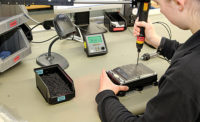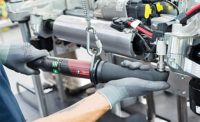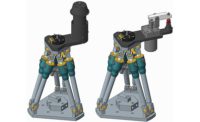Automated assembly is becoming increasingly common, even for small manufacturing companies. Robotic assemblers improve productivity and boost output while ensuring that results are more consistent. Robots have long been used for assembly tasks such as welding. But, for other applications, such as tightening threaded fasteners, adoption of automation has been slower.
Now, however, electric torque screwdrivers are available that are designed to work with, or that can be adapted to work with, robotic assemblers. If properly set up, these automation tools can free workers from the repetitive task of tightening fasteners. Because robots never forget a step, automation can significantly reduce errors and increase your product’s reliability. Just be sure automation is properly set up, that you choose the right tools and support them with auxiliary systems, and that you implement quality control processes and a strict calibration schedule.
The Importance of Torque
Torque is one of those terms that everyone has heard of, but only a relative few are comfortable talking about. In the world of fasteners and the tools that tighten them, torque is a measure of radial force, determining the amount of tension the fastener and the joint it clamps together are under.
Torque matters for product reliability. If too much is applied, then damage to the fastener or the joints could occur. Conversely, if too little is applied, the joint won’t reliably hold together. Even small vibrations can begin disengaging the fastener. Either will result in a faulty product that doesn’t meet standards.
The concept of torque is important for a range of assembly line products. Automobiles, satellites, electronics and medical devices are all built using threaded fasteners. Installing these fasteners exactly to torque specifications matters a great deal. Cracking the plastic housing on every tenth hard drive case will cut deeply into the bottom line. A medical device manufacturer that delivers a just a few faulty implants will likely end up answering to Congress or a trial lawyer.
As such, choosing the right torque tool for automated assembly, and backing it with the right processes and procedures, is critical for your company’s reputation, bottom line and future.
A robotic electric torque screwdriver with a relatively low maximum torque limit is the ideal tool for automated assembly. Heavy-duty fastening applications that require a hundred or several hundred foot-pounds of torque are usually done by experienced workers equipped with pulse tools or other power tools. Only rarely can highly specialized machines be integrated into an assembly line for heavy-duty fastening. This is because of the initial difficulty of automating the assembly process, issues that happen when fastening is automated, and how these issues are magnified as size scales up.
Automated assembly systems can easily monitor and control the amount of torque applied to each fastener. When it comes to process control, however, automated assembly systems tend to be less successful. They just don’t have the same physical senses that people do. For example, automated assembly systems cannot always tell if they’ve picked up a fastener correctly. Similarly, if the fastener is cross-threaded, they don’t stop and reset the fastener.
These issues must be addressed through a combination of precise assembly line layout and careful programming. The larger the fastener being tightened, the more emphasis must be placed on physically engineering process control rather than relying on programming. This reduces the flexibility of the assembly process and can limit your options. That’s why some manufacturers often find it more cost-effective to have workers equipped with power tools install large fasteners instead.
It’s a whole different story when assembling electronics and medical devices. These devices are small and therefore use smaller fasteners. In addition, many of these devices are assembled in clean rooms, in which case automated assembly offers significant improvements in production time due to the removal of potential sources of contamination.
Error-proofing can be handled with a screw counter that detects and eliminates screwdriving errors. It’s like putting the eyes and ears of a quality control manager where they are needed most—right at the point of assembly. An automated screw presenter makes the assembly process more efficient by mechanically presenting a screw to a fixed pick-up point for a robotic electric screwdriver to rapidly pick up screws and complete the fastening process. This, of course, takes careful programming and a precision electric torque screwdriver that is made for automation—which means the torque screwdriver must be properly calibrated and working on spec.
Calibrating Torque Tools
Over time, even quality tools can slip out of specification and deliver outputs that are inconsistent with specifications. Due to the speed and volume of automated assembly processes, errors can propagate quickly—and expensively—throughout an assembly line. The longer you allow your tools to go between torque verification and torque calibration, the more likely it is that you will experience issues with fastening, leaving you to field calls from disappointed shareholders, outraged customers or curious legislators, depending on your industry.
Fortunately, there are multiple options for a torque calibration plan, and they can be scaled to your company’s size and output needs. Large manufacturers with high output levels will find it is worth their while to set up a torque calibration laboratory in-house. Many torque tool manufacturers also sell the equipment needed to calibrate those tools. Torque analyzers, torque sensors and run-down adapters fit right onto a benchtop in your plant and can be used to keep your manual and powered torque tools within specifications on a routine schedule. If a tool goes off of spec unexpectedly, you can prioritize its calibration and get it back on line quickly, without having to send it off to an outside service.
An in-house calibration lab, though, is more than the tools needed to perform calibration; it must be operated by skilled technicians, and this additional labor cost may make in-house calibration too great of a cost for smaller manufacturing concerns. For these operations, the answer is to purchase torque tools for automated assembly lines from a manufacturer that specializes in providing for manufacturers rather than individual consumers. These torque tool manufacturers fully back their tools with calibration plans and understand how vital torque control is for automated assembly. Companies like Mountz, for instance, offer rush calibration services for vital torque tools.
Future of Automated Assembly
It may seem a bit odd to think of automated assembly as an immature technology, since robotic arms and other automation technologies have been around for decades. However, developments in sheer computational power and artificial intelligence are just getting started, and they’re still not present on most manufacturing floors. Regardless of these new developments, torque control has been, and will continue to be, absolutely vital to assembly lines, whatever their level of automation.
Manufacturing companies should make every effort to procure precision torque tools and the error-proofing aids to support them, in addition to developing the proper procedures to guarantee precision. Purchasing torque tools from a manufacturer that fully backs them is one of the best steps for automating an assembly line and avoiding errors. This way, you can be confident that your assembly line will be free of liabilities and set up for success in future developments.







